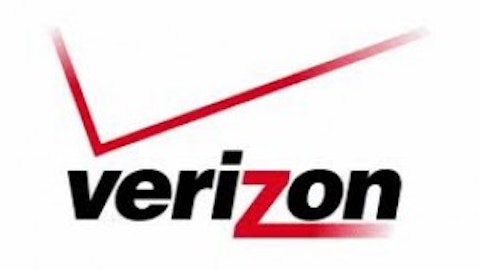
The Most Important Division Is Killing Everyone Else
Verizon’s growth driver is their Verizon Wireless division, and I don’t know how investors could ask the company to do more than they did in the last three months. Verizon added 2.2 million retail net additions and 2.1 million of these were postpaid subscribers. By comparison, AT&T added 1.1 million new subs, and 780,000 were postpaid subscribers. It took Sprint Nextel Corporation (NYSE:S) nine months last year to add 942,000 subscribers. An even smaller player MetroPCS Communications Inc (NYSE:PCS) has even more trouble, with a net loss of over 93,000 subscribers in the last three months of 2012. The bottom line is, Verizon Wireless is taking subscribers from other companies and flat outgrowing everyone.
Some might suggest that Verizon is gaining these subscribers with promotions, but when they are off contract, they can easily leave. However, the numbers just don’t bear out that conclusion. In fact, Verizon has consistently had one of the lowest churn rates in the industry. In the last quarter, Verizon’s churn rate was just 0.95%. By comparison, AT&T’s rate was 1.19%, Sprint’s churn was 2.08%, and MetroPCS’ churn was 3.6%. While it’s true that MetroPCS’ churn is on prepaid subscribers and not postpaid, this even more enforces the point. When customers sign a contract, they are more likely to stick around.
Maybe the most convincing piece of evidence that Verizon Wireless is the king of the hill is this division’s operating margin. Verizon reported a 24% operating margin last quarter. AT&T’s wireless margin was just 14.5% by comparison. Looking at the smaller players, MetroPCS managed a margin of 23.21%, and Sprint reported a negative margin last quarter. As you can see, no one does it better than Verizon Wireless.
Wireline Wasn’t Bad, But Oh Those Financials
Verizon’s wireline business isn’t the growing enterprise it once was, but the company is offsetting their landline losses with increased broadband and video customers. On an annualized basis, Verizon lost 6.8% of their voice connections last quarter. By comparison, AT&T reported an annualized 13% decline. On a positive note, Verizon added 12.6% more FIOS Internet customers and 13.3% more FIOS Video customers.
What is far more important to most investors is, Verizon’s ability to generate cash flow. This was one measure where AT&T actually outperformed their rival, with free cash flow up 34.7% versus a 13.11% at Verizon. The two smaller players we’ve looked at turned in mixed results. On the one hand, MetroPCS saw free cash flow nearly double in the last four quarters versus the prior year. However, Sprint saw their free cash flow drop from over $560 million in 2011 to just $179 million in the last four quarters. With Verizon generating over $5.6 billion in free cash flow in just one quarter, the smaller players would need years and years to try and match this performance.
Where Verizon is unmatched is in their dividend and payout ratio combination. Verizon pays a current yield of about 4.75% versus AT&T’s yield of roughly 5.2%. While Verizon’s yield is lower, their free cash flow payout ratio is significantly lower. In the last three months, Verizon used just 34.16% of its free cash flow to cover the dividend, AT&T used 51.96% of their free cash flow. Since neither Sprint nor MetroPCS pay dividends, they can’t match their bigger competition if income investors come calling.
Don’t Mess With The Rest, Buy The Best
Investors have several investment choices, but the numbers don’t lie. AT&T pays a yield at 5.21%, which is better than Verizon, but has a lower expected growth rate of 5.68%. Sprint can only be considered as a turnaround story, as analysts are forecasting a loss for 2013, and just 5% EPS growth in the next five years. MetroPCS might look attractive, with analysts looking for EPS growth of 13.82%, and the shares trading for about 13 times earnings. However, MetroPCS has a higher churn rate, net subscriber losses, and a debt-to-equity ratio that is two times higher than AT&T and nearly three times higher than Verizon.
In nearly every financial and subscriber metric, Verizon outperforms their competition. Investors receive a 4.75% yield and analysts expect 7.98% EPS growth. The company has the lowest churn rate, the best margin, and highest subscriber additions of any of the companies we’ve looked at. The bottom line is, anything blue (AT&T) can do, red (Verizon) can do better. To be honest, Verizon is doing almost everything better than anyone else in the industry.
The article Anything Blue Can Do Red Can Do Better originally appeared on Fool.com and is written by Chad Henage.
Copyright © 1995 – 2013 The Motley Fool, LLC. All rights reserved. The Motley Fool has a disclosure policy.





